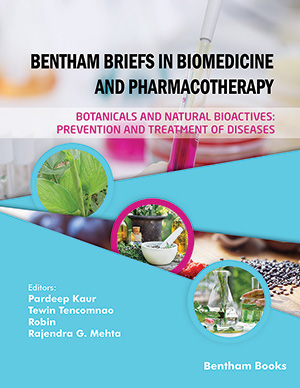Abstract
Mother Nature is an indispensable source of bioactive natural products. Bioactive secondary metabolites have played a crucial role in the drug development and discovery process; mainly, anticancer and antibiotic molecules are extensively enriched with molecules of natural origin. Anthocyanins are water-soluble secondary metabolites found in most species in the plant domain, especially flowers, fruits, and tubers. These natural vacuolar pigments belong to the chemical class of phenolic moieties, which are responsible for the shiny orange, red, blue, pink, and violet colors in the fruits, flowers, and vegetables. Chemically, anthocyanins comprise a core structure in the form of flavylium cation or 2-phenylbenzopyrylium, and these natural colorants are polyhydroxy and polymethoxy analouges of this flavylium cation and can have sugar moieties or acylated groups linked at different positions. Currently, these molecules have raised a growing interest because of their wide range of colors, innocuous and beneficial health effects, and commercial application in functional foods, nutraceuticals, pharmaceutical and cosmetic industries. However, interest in anthocyanin derivatives has noticeably enhanced in recent years due to their higher stability, improved bioavailability in biological matrices, and better use in food matrices and cosmetic products. Due to the enormous potential of natural anthocyanins and their derivatives, this review tries to cover syntheses of anthocyanins and their analogues, chemical derivatization of anthocyanins, and anticancer activities, such as breast, colorectal, leukemia, lung, prostate, and skin cancer of anthocyanins efficiently.
Keywords: Anthocyanins, anticancer activities, bioactive natural products, drug discovery, semi-synthesis, synthesis.
[http://dx.doi.org/10.1016/j.canlet.2008.05.020] [PMID: 18571839]
[http://dx.doi.org/10.1002/ptr.5642] [PMID: 27221033]
[http://dx.doi.org/10.3390/molecules25235500] [PMID: 33255297]
[http://dx.doi.org/10.1080/10408399509527704] [PMID: 7576162]
[http://dx.doi.org/10.3390/molecules25173809] [PMID: 32825684]
[http://dx.doi.org/10.1111/j.1365-313X.2008.03447.x] [PMID: 18476875]
[http://dx.doi.org/10.1039/D0NP00003E] [PMID: 32319494]
[http://dx.doi.org/10.1021/acs.chemrev.7b00653] [PMID: 29516724]
[http://dx.doi.org/10.1002/slct.202002836]
[http://dx.doi.org/10.1016/j.tet.2020.131801]
[http://dx.doi.org/10.2174/1385272825666210303112302]
[http://dx.doi.org/10.1002/slct.202100206]
[http://dx.doi.org/10.1016/j.heliyon.2019.e02107] [PMID: 31417967]
[http://dx.doi.org/10.1016/S0031-9422(03)00438-2] [PMID: 14561507]
[http://dx.doi.org/10.1016/j.foodchem.2008.09.001]
[http://dx.doi.org/10.1080/16546628.2017.1361779] [PMID: 28970777]
[http://dx.doi.org/10.3390/antiox8040085] [PMID: 30986936]
[http://dx.doi.org/10.1371/journal.pone.0174116] [PMID: 28329021]
[http://dx.doi.org/10.1186/s12974-016-0752-y] [PMID: 27821173]
[http://dx.doi.org/10.3390/ijms160921555] [PMID: 26370977]
[http://dx.doi.org/10.1111/1541-4337.12024] [PMID: 33412667]
[http://dx.doi.org/10.1093/jaoac/88.5.1269] [PMID: 16385975]
[http://dx.doi.org/10.1016/0040-4020(77)88025-3]
[http://dx.doi.org/10.1016/S0040-4020(01)92086-1]
[http://dx.doi.org/10.1039/CT9252701128]
[http://dx.doi.org/10.1021/ol0614976] [PMID: 16869672]
[http://dx.doi.org/10.1016/S0040-4039(00)00826-1]
[http://dx.doi.org/10.1039/p19920003043]
[http://dx.doi.org/10.1271/bbb.60.1495] [PMID: 8987602]
[http://dx.doi.org/10.1016/j.tetlet.2007.06.134]
[http://dx.doi.org/10.1016/S0040-4039(00)01767-6]
[http://dx.doi.org/10.1016/0031-9422(95)00383-I]
[http://dx.doi.org/10.1016/0031-9422(91)80127-M]
[http://dx.doi.org/10.1002/jlcr.1120]
[http://dx.doi.org/10.1021/jo01203a003]
[http://dx.doi.org/10.1002/cber.19520851213]
[http://dx.doi.org/10.1021/acs.jnatprod.5b01055] [PMID: 26852623]
[http://dx.doi.org/10.1021/acs.jnatprod.8b00517] [PMID: 30629440]
[http://dx.doi.org/10.1021/jf061085b] [PMID: 16939355]
[http://dx.doi.org/10.1021/jf960252c]
[http://dx.doi.org/10.1016/S0031-9422(97)00772-3] [PMID: 9611832]
[http://dx.doi.org/10.1016/j.foodchem.2014.11.062] [PMID: 25529709]
[http://dx.doi.org/10.1007/s11130-013-0337-1] [PMID: 23378056]
[http://dx.doi.org/10.1007/s10142-014-0427-7] [PMID: 25504198]
[http://dx.doi.org/10.1021/jf201546j] [PMID: 21806064]
[http://dx.doi.org/10.3390/molecules17021483] [PMID: 23442981]
[http://dx.doi.org/10.1021/jf0110755] [PMID: 11929308]
[http://dx.doi.org/10.1016/j.foodchem.2011.01.069] [PMID: 25214087]
[http://dx.doi.org/10.1016/j.ifset.2007.03.006]
[http://dx.doi.org/10.1002/ptr.3213] [PMID: 20564502]
[http://dx.doi.org/10.1021/jf8021496] [PMID: 18959409]
[http://dx.doi.org/10.2174/157017808785982211]
[http://dx.doi.org/10.1021/jf300998p] [PMID: 22703561]
[http://dx.doi.org/10.1016/j.tifs.2017.07.005]
[http://dx.doi.org/10.1111/j.1755-0238.2007.tb00244.x]
[http://dx.doi.org/10.1016/j.jcrpr.2017.07.001]
[http://dx.doi.org/10.3322/caac.21166] [PMID: 23335087]
[http://dx.doi.org/10.1038/bjc.2012.581] [PMID: 23299535]
[http://dx.doi.org/10.1038/nature12624] [PMID: 24048065]
[http://dx.doi.org/10.3322/caac.21332] [PMID: 26742998]
[http://dx.doi.org/10.1111/j.1349-7006.2009.01452.x] [PMID: 20070305]
[http://dx.doi.org/10.1002/j.1460-2075.1984.tb02287.x] [PMID: 6396087]
[http://dx.doi.org/10.3233/JBR-180366]
[http://dx.doi.org/10.1093/nar/gks294] [PMID: 22467215]
[http://dx.doi.org/10.1093/oxfordjournals.epirev.a036115] [PMID: 8405211]
[http://dx.doi.org/10.1016/S0140-6736(95)92713-1] [PMID: 7564675]
[http://dx.doi.org/10.1039/C9FO01721F] [PMID: 31621765]
[http://dx.doi.org/10.1080/01635581.2019.1654529] [PMID: 31448633]
[http://dx.doi.org/10.3892/ijmm.2017.3183] [PMID: 29039492]
[http://dx.doi.org/10.3322/caac.21208] [PMID: 24399786]
[http://dx.doi.org/10.1002/ijc.29210] [PMID: 25220842]
[http://dx.doi.org/10.3390/molecules21020169] [PMID: 26840292]
[http://dx.doi.org/10.1017/S0007114518003136] [PMID: 30375302]
[http://dx.doi.org/10.1021/jf060976g] [PMID: 17061839]
[http://dx.doi.org/10.1016/j.fct.2018.08.078] [PMID: 30194994]
[http://dx.doi.org/10.1159/000475524] [PMID: 28494451]
[http://dx.doi.org/10.3945/ajcn.115.117507] [PMID: 26537935]
[http://dx.doi.org/10.1016/j.lrr.2016.09.001] [PMID: 27752467]
[http://dx.doi.org/10.1056/NEJMra1406184] [PMID: 26376137]
[http://dx.doi.org/10.3892/etm.2017.4467] [PMID: 28672893]
[http://dx.doi.org/10.1021/jf405235j] [PMID: 24471438]
[PMID: 29172259]
[http://dx.doi.org/10.1016/j.taap.2008.03.023] [PMID: 18499206]
[http://dx.doi.org/10.3233/JBR-160120]
[http://dx.doi.org/10.1016/j.canlet.2012.05.029] [PMID: 22659736]
[http://dx.doi.org/10.1016/j.ejca.2009.12.014] [PMID: 20116997]
[http://dx.doi.org/10.1038/nrurol.2014.42] [PMID: 24595118]
[http://dx.doi.org/10.1677/erc.0.0090061] [PMID: 11914183]
[http://dx.doi.org/10.1101/cshperspect.a030635] [PMID: 29101113]
[PMID: 19287965]
[http://dx.doi.org/10.3892/ijo.2015.3130] [PMID: 26315029]
[http://dx.doi.org/10.1038/s41598-019-39589-1] [PMID: 30867440]
[http://dx.doi.org/10.3390/biomedicines8090336] [PMID: 32916849]
[PMID: 10750668]
[http://dx.doi.org/10.1080/16546628.2017.1325308] [PMID: 28680383]
[http://dx.doi.org/10.1007/s11130-017-0638-x] [PMID: 29129015]
[http://dx.doi.org/10.1007/s10517-016-3554-4] [PMID: 27878717]
[http://dx.doi.org/10.1055/s-0033-1350954] [PMID: 24214832]
[http://dx.doi.org/10.1039/C6FO00445H] [PMID: 27165855]
[http://dx.doi.org/10.1111/1750-3841.15497] [PMID: 33078395]
[http://dx.doi.org/10.1021/acs.jafc.6b04096] [PMID: 27790915]
[http://dx.doi.org/10.1093/carcin/bgy009] [PMID: 29361151]
[http://dx.doi.org/10.1016/j.jnutbio.2015.08.005] [PMID: 26383537]
[http://dx.doi.org/10.1016/j.fct.2009.12.031] [PMID: 20060025]
[http://dx.doi.org/10.1158/1940-6207.CAPR-14-0003] [PMID: 24667581]
[http://dx.doi.org/10.1021/acs.jafc.8b06209] [PMID: 30586992]
[http://dx.doi.org/10.3390/molecules24112142] [PMID: 31174320]
[http://dx.doi.org/10.4236/abb.2018.99030]
[http://dx.doi.org/10.1039/C7FO00882A] [PMID: 28991298]
[http://dx.doi.org/10.5115/acb.20.085] [PMID: 32839357]
[http://dx.doi.org/10.1002/mc.22995] [PMID: 30828884]
[http://dx.doi.org/10.3945/an.115.009233] [PMID: 26374184]
[http://dx.doi.org/10.1039/C8FO01492B] [PMID: 30255184]
[http://dx.doi.org/10.1002/biot.200600004] [PMID: 16892265]
[http://dx.doi.org/10.1080/01635581.2012.697597] [PMID: 22823889]
[http://dx.doi.org/10.1158/1078-0432.CCR-10-1260] [PMID: 21123457]
[http://dx.doi.org/10.1007/s00421-018-3978-9] [PMID: 30173287]
[http://dx.doi.org/10.1158/0008-5472.CAN-08-0568] [PMID: 18559542]































